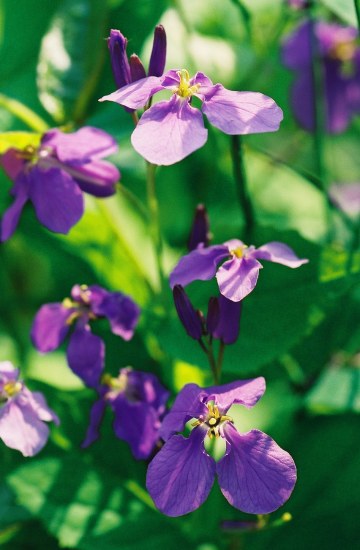Hanadaikon
Orychophragmus violaceus
 |
Beauty passed by (April 2001)

HanadaikonOrychophragmus violaceus
Beauty passed by (April 2001)
|
|
|
The most difficult thing about this plant is its name. I've heard it called hanadaikon ("flower-daikon"), but other names include Ooaraseitou, Murasaki-hana-na ("purple-flower-rape"), Shikinsou ("purple-gold-plant"), and Shokatsusai (the Chinese name). It is a member of the Brassicaceae, the large family that includes vegetables such as cabbages and radishes. Of course, daikon is the name of the giant Japanese radishes, known in British supermarkets as "mooli radish", another member of the family. (The old name of this family, Cruciferae, refers to the distinctive cross-shaped arrangement of the petals.) At least, I hope this is right - by searching in Japanese for hanadaikon I also found claims that it refers to Hesperis matronalis, or sweet rocket. This at least would explain the entry I found in Kenkyusha's Japanese-English dictionary, which gives "dame's violet, [gilliflower, rocket]; sweet rocket." Well, some web searching suggests that "my" hanadaikon is quite similar to this sweet rocket, but I'm fairly sure it has no strong scent. So it seems unlikely to be a secret invader from Europe. Orychophragmus violaceus is native to China, and was apparently introduced to Japan in the Edo era (1650ish to 1850ish) as a decorative plant, but has since escaped to the wild. I find fragmentary references to eating it, but nothing very concrete. I also found the name "Chinese Violet Cress" together with the Latin, which suggests it may be grown in the West as an exotic herb of some sort. Generally, though, it seems doomed to be ignored. I did find comments on Japanese pages about the attractiveness of the flowers in a mass, and ah, that's it! One of the most amazing sights of southern England is that of a beech wood in spring, when to the exquisite backlit effect of the emerging leaves is added the blue haze of a mass of floating bluebells. And even if there are no beech woods near here, this is surely the "bluebell" of Japan.
Links
|
© Brian Chandler 2001
This page is copylefted
Feedback: Guestbook -
Email -
Snailmail -
Linking
|
Other departments
|
Japanese plant photoguides - this is in Haru-no-hana, p. 218 |
Created November 2001 - WDG validated